在66 Ma左右的中生代与新生代之交(Renne et al., 2013),全球发生了重大的生物绝灭事件(Kauffma et al., 1986;Raup et al., 1986;Fastovsky et al., 1987;Longrich et al., 2011,2012),其中最引人注目的是恐龙的集群绝灭以及古近纪生物劫后复苏和哺乳动物的兴起事件(Hunter et al., 2002;Debey et al., 2014)。因此,白垩系—古近系界线(Cretaceous—Paleogene boundary, KPB)研究成为全球界线层型(Global Stratotype Section and Point, GSSP)研究的热点(李伟同等,2010;Sosa-Montes de Oca et al., 2017,2018;Martin et al., 2017)。突尼斯的El Kef剖面被批准、确认为全球海相白垩系—古近系界线层型(Remane et al., 1999;戎嘉余等,2003),而它未能解决全球分布广泛的陆相白垩纪、古近纪地层领域诸多问题,因此建立非海相白垩系—古近系界线层型很有必要。
目前非海相KPB研究程度较高的剖面大多数集中在北美中西部地区(Allan et al., 1945;Baltz et al., 1966;Mountjoy,1967;Norris et al., 1977;Jerzykiewicz et al.,1980;Saito et al., 1986;Fastovsky,1987;Li Baofang et al., 1988;Braman et al., 1991;Eberth et al., 1995;Hunter et al., 1997;Vajda et al., 2001;Mull et al., 2004;Wilson, 2014),我国非海相KPB剖面主要集中在南雄盆地(童永生等,1976,2002;黄仁金,1988;孙孟蓉等,1982;刘云等,1986;李曼英,1989;余汶等,1990;张显球,1987,1991,1992a,b; 张显球等, 2006a, b,2008;赵资奎等,1991,1998,2000,2009;拉塞尔等,1993;Zhao et al., 2002;凌秋贤等,2005)、嘉荫盆地(刘牧灵,1983;陈丕基等,1998;孙革等,2003,2005,2013;孙革,2009,李伟同等,2010;Suzuki et al., 2011)、松辽盆地(陈丕基等,2012;Wan Xiaoqiao et al., 2012;李莎等,2013)、苏北—南黄海盆地(吴其切等,1984;郑亚惠等,1984;杨恒仁等,1989;陈丕基等,2008;)、江汉盆地(李伟同,1985,2003; 李伟同等,2010;Li Weitong et al., 1998,2006;刘耕武等,2009)等地,同样也取得了不少研究成果。但到目前为止,还未真正找到一条地层连续可靠的剖面,也未发现真正的界线黏土层(刘耕武等,2009)。
山东平邑盆地位于鲁中隆起区,受北部蒙山隆起和南部尼山隆起高角度正断层的控制,盆地形态呈北西—南东向带状展布(杜圣贤等,2016)(图1)。盆内基底为新太古代峄山序列的TTG(Trondhjemite—Tonalite—Granodiorite, 奥长花岗岩—英云闪长岩—花岗闪长岩)岩系和傲徕山序列的花岗岩(张增奇等,2014a, b),古生代寒武系长清群、九龙群,奥陶系马家沟群以及石炭—二叠系月门沟群组成,盖层为中新生代淄博群、莱阳群、青山群以及官庄群(张增奇等,1996)。其中官庄群的卞桥组是我国中、新生界界线上下非常典型的一套厚约数百米的以碳酸盐岩为主、含石膏矿层的河湖相沉积,也是目前所知我国同期陆相湖盆中连续沉积灰岩厚度最大的地层单元之一,蕴藏着十分丰富的生物、沉积、陆相碳酸盐湖盆演化等重要地质信息。前人在岩石地层、微体古生物等方面做了大量工作并取得了一些成果,尤其在KPB研究方面取得了重要进展(李守军等,2003;曲日涛等,2006;杨景林等,2013;杜圣贤等,2013,2015,2019;张增奇等,2014a;于学峰等,2014;Li Sha et al., 2015;李莎等,2015)。但这些工作基本属于生物地层范畴,研究手段相对单一。
本文将在以上研究成果以及多年在平邑盆地的工作进展基础上,通过对PYZK01科学浅钻的研究,在生物地层特征分析基础上,对该钻孔磁性地层特征进行分析,并通过对比国际地磁极性年表,为平邑盆地KBP研究提供更多样的材料支撑,这在该地区尚属首次。
1 岩石地层特征
近些年,笔者随研究团队在平邑盆地开展了大量的工作,并进行了大量野外露头剖面的实测(图1),虽然地层整体出露较完整,但也因覆盖出现不连续的情况。为进一步精确寻找该地区的白垩系—古近系界线,于2013年选取了野外露头出现相对连续的佟家庄北剖面处进行科学钻孔的施工,钻孔编号为PYZK01。该钻孔位于平邑县卞桥镇佟家庄北东约500 m处的路边,深60 m,现已被作为农用水井(图1)。
钻孔整体岩性特征为:上段以肉红色灰岩、泥灰岩、泥晶灰岩为主,偶见核形石等,夹灰白色灰岩、泥灰岩,局部见少量薄层钙质泥岩;中段以深灰色、深灰绿色泥灰岩、钙质泥岩为主,见大量生物碎屑;下段以灰白色灰岩、泥灰岩、泥晶灰岩为主,夹灰紫色泥晶灰岩、泥灰岩,靠近底部夹薄层状灰绿色钙质泥岩。钻孔整体岩性连续,未见沉积间断现象,表现为一套滨浅湖相、浅湖相交替出现的沉积特征(图2)。
钻孔岩性记录
厚度(60.00 m)
------------未见顶------------
卞桥组一段
1. 第四纪黄土覆盖
2.20 m
2. 整体为肉红色泥灰岩、砂砾屑泥灰岩,中部夹厚约0.77 m灰白色含核形石泥质灰岩,底部为厚约0.21 m灰紫色钙质泥岩
3.96 m
3. 上部为灰紫色砾屑泥灰岩,见介形类: Eucypris ? sp., 下部42 cm为肉红色泥灰岩
1.82 m
4. 灰黄色钙质砾屑砂屑泥灰岩,含生物碎屑
0.54 m
5. 灰白色泥质灰岩、灰岩,中部夹厚约0.1 m灰紫色砾屑泥灰岩
3.47 m
6. 整体为肉红色泥质灰岩,顶部0.47 m为土黄色、灰白色砾屑泥灰岩,见介形类:Cyprinotus sp.、Heterocypris sp.、Candona sp.;底部0.45 m为黄褐色含生物碎屑砾屑灰岩,见轮藻类:Sphaerochara cf. chinensis,见介形类:Cyprinotus sp.
3.99 m
7. 整体为肉红色泥灰岩夹灰白色泥灰岩,中部1.3 m为灰白色泥质灰岩
4.05 m
8. 上部为灰白色泥晶灰岩,下部为灰白色泥质灰岩
2.07 m
9. 上部为紫红色砂砾屑泥晶灰岩,见生物碎屑与核形石;下部为紫红色泥质灰岩
1.23 m
10. 灰白色泥质灰岩,中上部夹厚0.5 m钙质泥质粉砂岩
1.65 m

图1 山东平邑盆地卞桥地区区域地质简图
Fig. 1 Regional geological map of Bianqiao area in Pingyi Basin, Shandong Province
11. 上部厚约0.35 m为灰紫色含砾泥灰岩,下部为灰绿色砂砾屑泥晶灰岩
0.60 m
12. 肉红色砂砾屑泥灰岩,见核形石,见孢粉类:Classopollis
1.70 m
13. 灰绿色与灰紫色含砾泥纹状灰岩交替互层
1.85 m
14. 黄绿色泥纹状藻灰岩,中部0.73 m为黄白色含砾泥纹状泥质灰岩
1.92 m
15. 灰绿色核形石灰岩
0.50 m
16. 灰—灰绿色砂砾屑生物碎屑泥晶灰岩
0.98 m
17. 上部为灰白色含生物碎屑灰岩、泥质灰岩,夹厚约0.55 m肉红色砂砾屑泥灰岩,下部为灰白色含生物碎屑泥晶灰岩
4.48 m
18. 上部1.77 m为灰—灰黑色含生物碎屑泥晶灰岩,见腹足类:Reesidella orientalis Pan,Physa sp., 见孢粉类:Concentricystes、Concavisporites、Cyathidites、C. minor、Leiotriletes、Deltoidospora、D. microlepioidites、D. adriensis、D. regularis、Trilobosporites minor、Lygodiumsporites、Punctatisporites、Hymenophyllumsporites、Sphagnumsporites、Granulatisporites、Pterisisporites、Polypodiaceaesporites、Schizaeoiporites、S. laevigataeformis、S. praeclarus、Abietineaepollenites、Pinuspollenites、Abiespollenites、Parcisporites、P. annulatus、P. parvisaccus、Rugubivesiculites、R. regosus、R. fluens、R. reductus、R. podocarpites、Ephedripites、E. (Ephedripites) notensis、E. (Distachyapites)、Marsypilete cretacea、C. annulatus、Quercoidites、Tricolpollenites;下部1.75m为灰黑色—深灰绿色含核形石砾屑—角砾状泥灰岩,见轮藻类: Chara yuntaishanensis var. acuta (Z. Wang),见孢粉类:Cyathidites、Deltoidospora、D. microlepioidites;中间为厚0.3 m灰黑色钙质泥质粉砂岩
3.82 m
19. 灰绿色砂砾屑泥灰岩、泥晶灰岩,见轮藻类:Porochara sp., 见腹足类:Truncarella sp.
2.10 m
20. 上部1.15 m为灰白色泥灰岩,下部0.43 m为紫红色砂砾屑泥灰岩
1.58 m
21. 灰白色泥灰岩,中上部夹厚约0.4 m肉红色砾屑灰岩
3.37 m
22. 灰紫色泥晶灰岩,见轮藻类:Gobichara cristata L. Grambast,Sinochara spp., Porochara anluensis Z. Wang 1.60 m
23. 灰白色灰岩、泥晶灰岩、泥灰岩,中上部夹厚约0.15 m黄绿色钙质泥岩,顶部见核形石
5.68 m
24. 灰绿色含生物碎屑钙质泥岩
0.50 m
25. 灰白色灰岩、泥灰岩,上部见核形石见轮藻类:Porochara anluensis Z. Wang,Porochara oblonga Z. Wang,Sinochara sp., Lychnothamnus turpanensis(MS),Turbochara specialis Z. Wang,见腹足类:Amnicola sp;中部夹0.44 m含生物碎屑钙质泥岩,见轮藻类:Porochara anluensis Z. Wang,Porochara gonganzhaiensis Z. Wang,Gobichara cristata L. Grambast,Sinochara sp.
4.36 m
------------未见底------------
2 生物地层特征
平邑盆地卞桥组古生物化石含量丰富,本文以PYZK01钻孔所采的56块古生物化石样品为背景,样品编号为PY1-1~PY1-56,基本平均分布于钻孔各处(图2);通过实验测试、分析鉴定获得了丰富的轮藻、孢粉、介形类和腹足类化石(图2、图3)。
2.1 轮藻化石
本次共分析轮藻样品33件,其中有轮藻化石样品7件。从化石纵向分布看(图2),12.25 m见有中华球状轮藻Sphaerochara cf. chinensis (Huang et Xu),其广泛见于我国古近纪及中新世地层,说明12.25 m以浅地层不早于古近纪。
40.03~58.40 m轮藻化石组合为:Porochara anluensis—Chara yuntaishanensis var. acuta —Turbochara specialis。发现的轮藻化石属种有安陆孔轮藻Porochara anluensis Z. Wang、公安寨孔轮藻Porochara gonganzhaiensis Z. Wang、长椭球孔轮藻Porochara oblonga Z. Wang,中华轮藻数种Sinochara spp.、吐鲁番灯枝藻Lychnothamnus turpanensis (MS)、特殊陀螺轮藻Turbochara specialis Z. Wang、克里斯特戈壁轮藻Gobichara cristata L. Grambast、云台山轮藻尖变种Chara yuntaishanensis var. acuta (Z. Wang)等(图2、图3)。其中,Gobichara cristata见于法国东南部马斯特里赫特阶、南黄海盆地长门岩组、准噶尔盆地红砾山组;Chara yuntaishanensis var. acuta (Z. Wang)见于江汉盆地跑马岗组和湖北京山云台山组、苏北盆地泰州组、南黄海盆地长门岩组、准噶尔盆地红砾山组以及阿根廷的Lonchoche组;Porochara anluensis见于湖北安陆公安寨组、南京方山赤山组、南黄海盆地长门岩组、松辽盆地四方台组、云南景洪曼宽河组、塔里木盆地中部古城组,相近类型见于西班牙Cuenca地区的Campanian—Maastrichtian阶、秘鲁和阿根廷Maastrichtian期地层(Koch & Blissenbach, 1960;Uliana & Musacchio, 1978);Porochara oblonga Z. Wang和Porochara gonganzhaiensis分别见于云南景洪曼宽河组和湖北京山公安寨组,后者还见于南黄海盆地长门岩组;Lychnothamnus turpanensis (MS)见于新疆吐鲁番盆地苏巴什组和准噶尔盆地北缘红砾山组、山东胶州地区胶州组;Turbochara speciaslis首见报道于江汉盆地跑马岗组(李伟同,1985,2003;杜圣贤等,2019),在洞庭盆地岩码头组、南黄海盆地长门岩组和准噶尔盆地红砾山组也有发现。由此可见,所有属种基本上均为晚白垩世最晚期的最常见分子。

图2 山东平邑盆地PYZK01钻孔微体古生物化石分布图
Fig. 2 Distribution of micropaleontological fossils in the Drill PYZK01 from Pingyi Basin, Shandong Province

图3 山东平邑盆地PYZK01钻孔的轮藻化石
Fig. 3 Charophytes fossils from the Drill PYZK01 in Pingyi Basin, Shandong Province
1—Sphaerochara cf. chinensis (Huang et Xu),钻孔12.25 m处,侧视;2~9—Microchara cristata L. Grambast,钻孔57.3 m处,2~4为和5~7分别为两个不同藏卵器的侧、顶、底视,8~9为不同藏卵器的侧视;10~16—Feistiella gonganzhaiensis (Z. Wang),钻孔57.3 m处,10为侧视,11~13和14~16为两个不同藏卵器的侧、顶、底视;17~22—Feistiella anluensis (Z. Wang),钻孔57.95 m处,17~19和20~22为两个不同藏卵器的侧、顶、底视;23~25—Turbochara specialis Z. Wang,钻孔58.4 m处,分别为侧、顶、底视;26~28—Lichnothamnus turpanensis MS,钻孔58.4 m处,分别为侧、顶、底视
1—Sphaerochara cf. chinensis (Huang et Xu), 12.25 m of zhe drill, lateral view; 2~9—Microchara cristata L. Grambast, 57.3 m of zhe drill, 2~4 and 5~7 are lateral view, apical view and basal view of two different gyrogonites respectively, 8~9 are lateral view of different gyrogonites; 10~16—Feistiella gonganzhaiensis (Z. Wang), 57.3 m of zhe drill, 10 is lateral view, 11~13 and 14~16 are lateral view, apical view and basal view of two different gyrogonites respectively; 17~22—Feistiella anluensis (Z. Wang), 57.95 m of zhe drill, 17~19 and 20~22 are lateral view, apical view and basal view of two different gyrogonites respectively; 23~25—Turbochara specialis Z. Wang, 58.4 m of zhe drill, are lateral view, apical view and basal view respectively; 26~28—Lichnothamnus turpanensis MS, 58.4 m of zhe drill, are lateral view, apical view and basal view respectively
根据前人在该地区所发现的轮藻生物群特征看,卞桥组一段下部地层时代为晚白垩世晚期,而卞桥组一段上部至卞桥组二段地层时代为古近纪(杨景林等,2013;Li Sha et al.,2015;李莎等,2015;杜圣贤等,2019)。而本钻孔所发现轮藻生物群证明,12.25 m以浅地层不早于古近纪,40.03 m以深的地层时代可确定为晚白垩世最晚期,因此该钻孔地层因位于卞桥组一段,且跨卞桥组一段上下亚段。
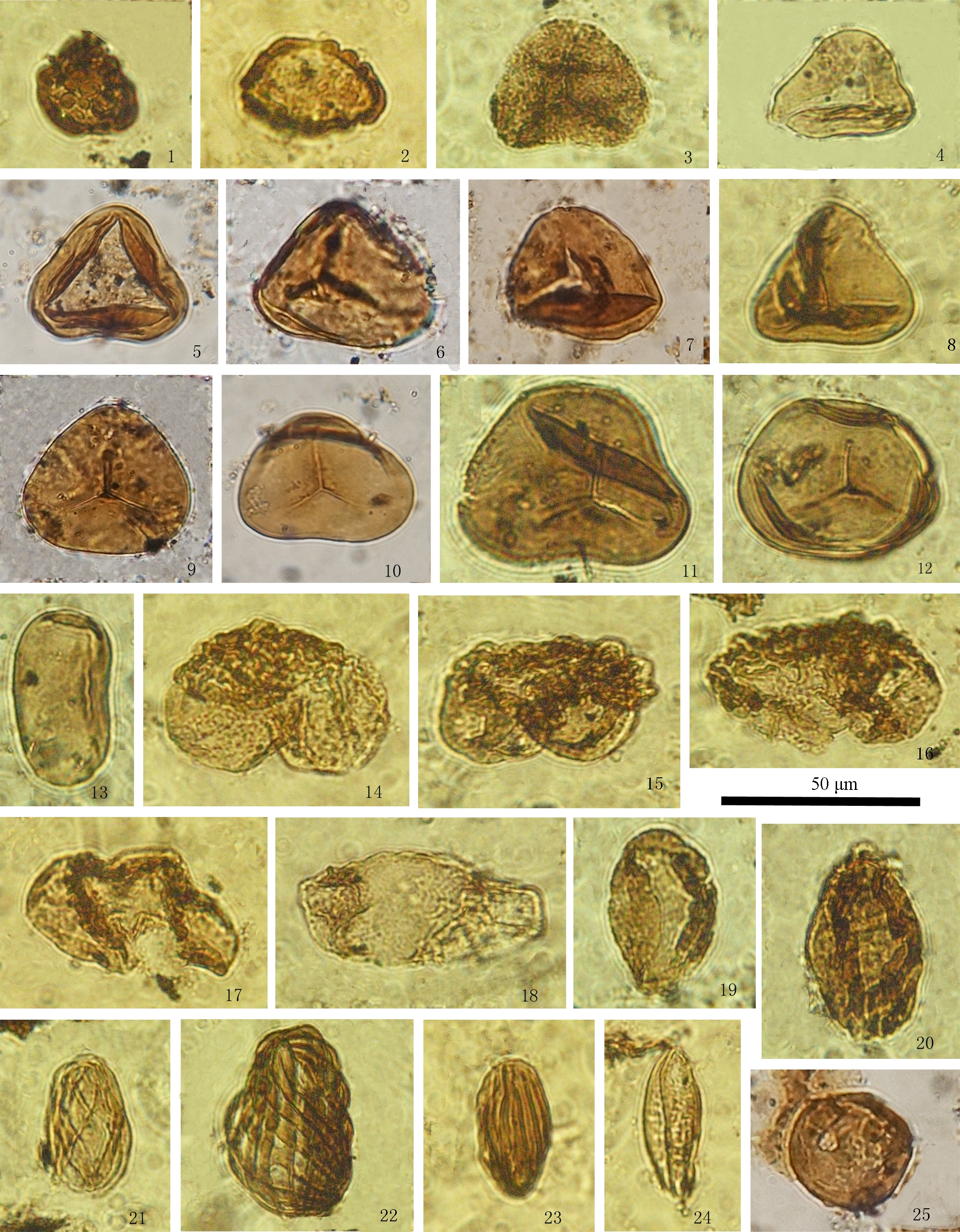
图4 山东平邑盆地PYZK01钻孔的孢粉化石
Fig. 4 Sporopollen fossils in the Drill PYZK01 from Pingyi Basin, Shandong Province
1~2—Pterisisporites Sung et Zheng, in Sung et Lee, 1976(钻孔37.96 m处);3—Granulatisporites Ibrahim,1933 emend. R. Poronie et Kremp, 1954(钻孔37.8 m处);4~5—Cyathidites minor Couper, 1953(钻孔38.35 m处);6—Deltoidospora regularis (Pflug) Song et Zheng, 1978(钻孔37.8 m处);7~8和12—Deltoidospora Miner, 1935 emend. R. Potonie, 1956(钻孔38.35 m处);9—Trilobosporites minor? Pocock, 1962(钻孔38.35 m处);10—Cyathidites Couper, 1953(钻孔40.3 m处);11—Lygodiumsporites R. Potonie, Thomson et Thiergart, 1950 emend, R. Potonie, 1956(钻孔38.35 m处);13—Polypodiaceaesporites Thiergart, 1938 ex Potonie, 1956(钻孔37.8 m处);14~16—Rugubivesiculites fluens Pierce, 1961(钻孔37.96 m处);17—Rugubivesiculites podocarpites Wang, 1981(钻孔37.96 m处);18—Abietineaepollenites Potonie, 1951 ex Delcourt et Sprumont, 1955(钻孔37.8 m处);19~20—Parcisporites Leschik, 1956(钻孔37.96 m处);21~22—Schizaeoisporites R. Potonei ex Delcourt et Sprumont, 1955,其中21位于钻孔37.8 m处,22位于钻孔37.96 m处;23—Ephedripites (Ephedripites) notensis (Cookson) Krutzsch, 1961(钻孔37.8 m处);24—Ephedripites (Distachyapites) Krutzsch, 1961(钻孔37.96 m处);25—Classopollis annulatus (Verbitzkaja ) Li, 1974(钻孔37.8 m处)
1~2—Pterisisporites Sung et Zheng, in Sung et Lee, 1976 (12.25 m of zhe drill); 3—Granulatisporites Ibrahim, 1933 emend. R. Poronie et Kremp, 1954 (37.8 m of zhe drill); 4~5—Cyathidites minor Couper, 1953 (38.35 m of zhe drill); 6—Deltoidospora regularis (Pflug) Song et Zheng, 1978 (37.8 m of zhe drill); 7~8 and 12—Deltoidospora Miner, 1935 emend. R. Potonie, 1956 (38.35 m of zhe drill); 9—Trilobosporites minor? Pocock, 1962 (38.35 m of zhe drill); 10—Cyathidites Couper, 1953 (40.3 m of zhe drill); 11—Lygodiumsporites R. Potonie, Thomson et Thiergart, 1950 emend, R. Potonie, 1956 (38.35 m of zhe drill); 13—Polypodiaceaesporites Thiergart, 1938 ex Potonie, 1956 (37.8 m of zhe drill); 14~16—Rugubivesiculites fluens Pierce, 1961 (37.96 m of zhe drill); 17—Rugubivesiculites podocarpites Wang, 1981 (37.96 m of zhe drill); 18—Abietineaepollenites Potonie, 1951 ex Delcourt et Sprumont, 1955 (37.8 m of zhe drill); 19~20—Parcisporites Leschik, 1956 (37.96 m of zhe drill); 21~22—Schizaeoisporites R. Potonei ex Delcourt et Sprumont, 1955, among them, 21 is located at 37.8 m of the drill, 22 is located at 37.96m of the drill; 23—Ephedripites (Ephedripites) notensis (Cookson) Krutzsch, 1961 (37.8 m of zhe drill); 24—Ephedripites (Distachyapites) Krutzsch, 1961 (37.96m of zhe drill); 25—Classopollis annulatus (Verbitzkaja ) Li, 1974 (37.8 m of zhe drill)
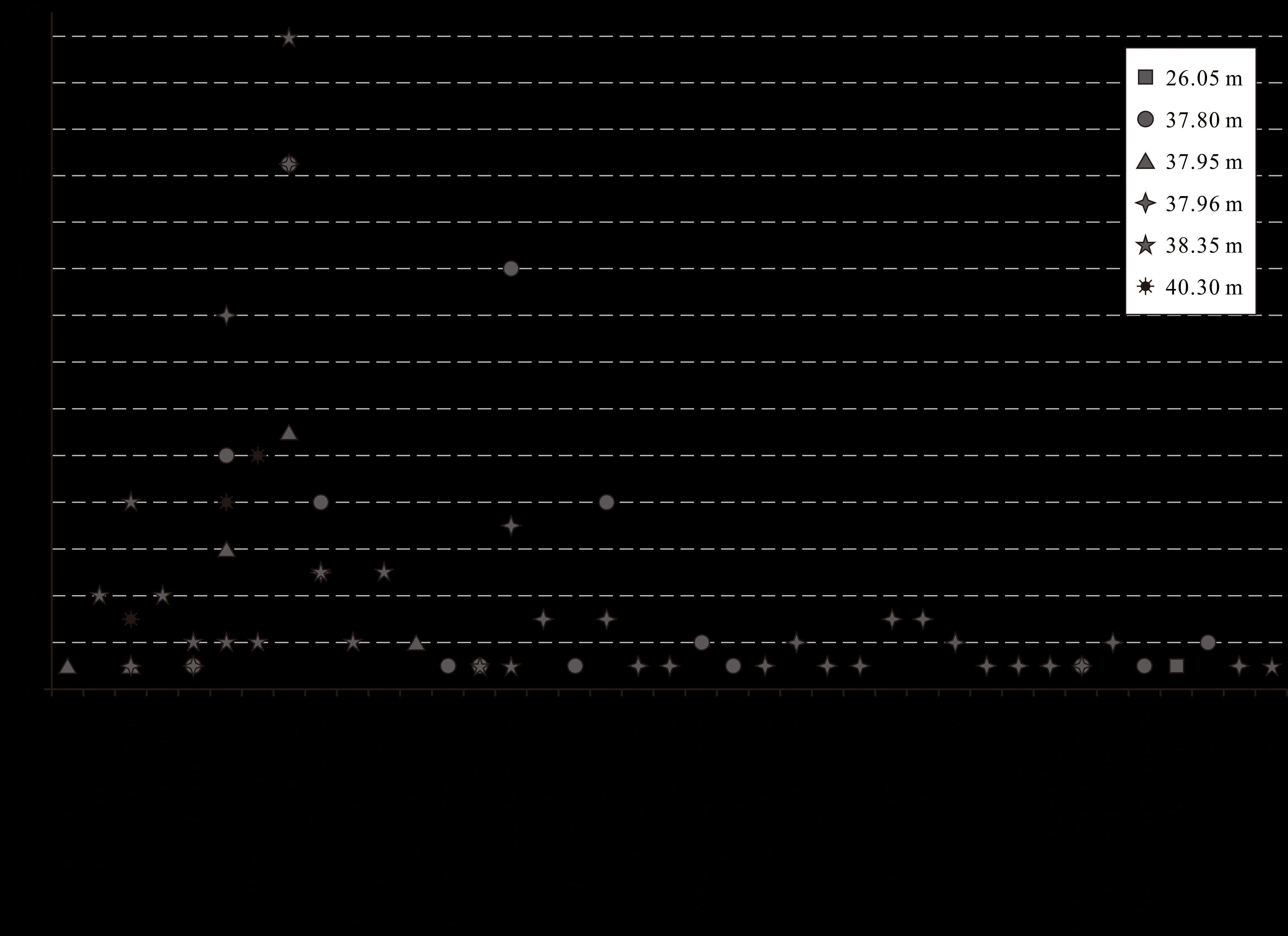
图5 山东平邑盆地PYZK01钻孔孢粉化石丰度分布图
Fig. 5 Distribution map of Sporopollen fossils in the Drill PYZK01 from Pingyi Basin in Shandong Province
2.2 孢粉化石
本次共分析孢粉样品31件,其中有孢粉化石样品5件,主要集中于37.8~40.3 m处(图2、图4),其它孔深未见孢粉化石。虽化石丰度和分异度不是很高,但保存状况较好,并建立了Deltoidospora adriensis—Rugubivesiculites—Schizaeoisporites孢粉化石组合。该组合以苔藓、蕨类植物孢子占绝对优势,含量82%~100%,平均94.07%;裸子花粉占4.62%;被子花粉占0.35%;绿藻类占0.95%(表1、图5)。
表1 山东平邑盆地PYZK01钻孔孢粉化石含量(%)分布
Table 1 Percentage distribution of Sporopollen fossils in the Drill PYZK01 in the Pingyi Basin, Shandong Province
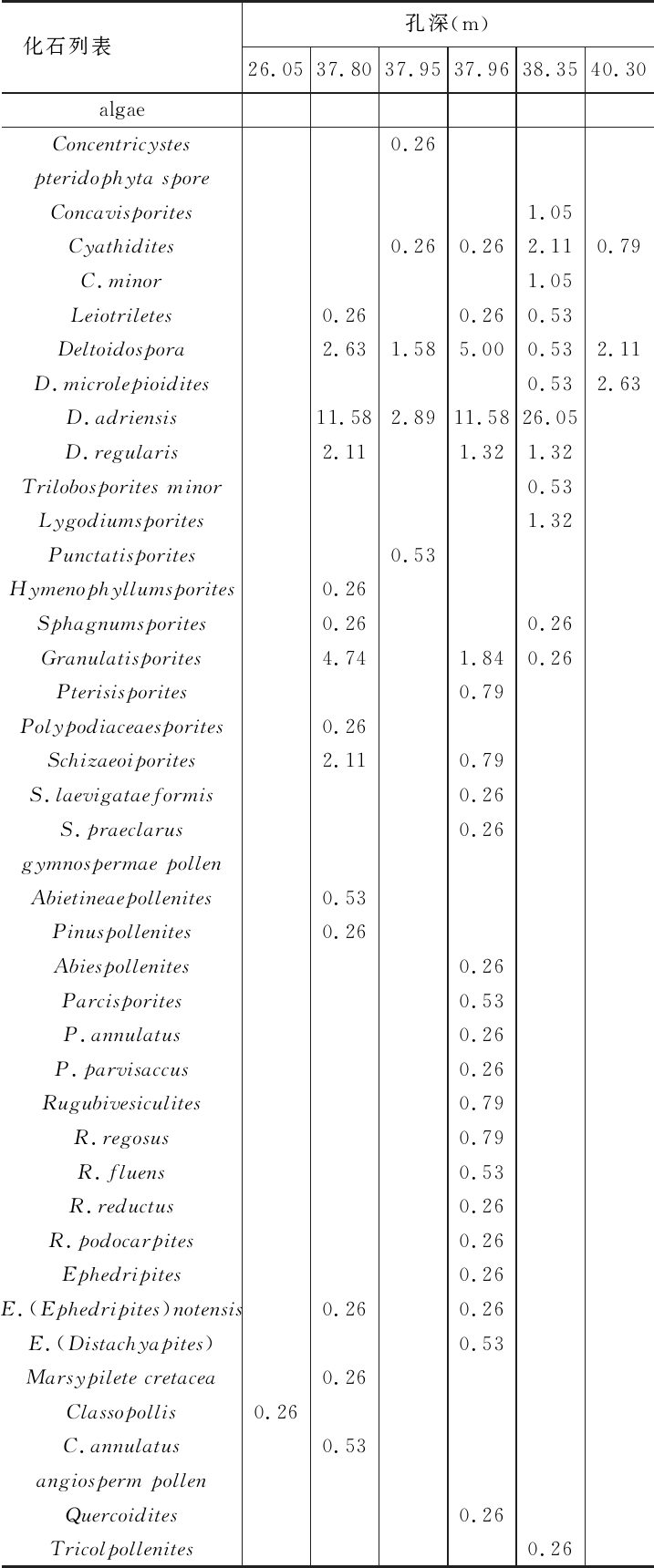
化石列表孔深(m)26.0537.8037.9537.9638.3540.30algaeConcentricystes0.26pteridophyta sporeConcavisporites1.05Cyathidites0.260.262.110.79C.minor1.05Leiotriletes0.260.260.53Deltoidospora2.631.585.000.532.11D.microlepioidites0.532.63D.adriensis11.582.8911.5826.05D.regularis2.111.321.32Trilobosporites minor0.53Lygodiumsporites1.32Punctatisporites0.53Hymenophyllumsporites0.26Sphagnumsporites0.260.26Granulatisporites4.741.840.26Pterisisporites0.79Polypodiaceaesporites0.26Schizaeoiporites2.110.79S.laevigataeformis0.26S.praeclarus0.26gymnospermae pollenAbietineaepollenites0.53Pinuspollenites0.26Abiespollenites0.26Parcisporites0.53P.annulatus0.26P.parvisaccus0.26Rugubivesiculites0.79R.regosus0.79R.fluens0.53R.reductus0.26R.podocarpites0.26Ephedripites0.26E.(Ephedripites)notensis0.260.26E.(Distachyapites)0.53Marsypilete cretacea0.26Classopollis0.26C.annulatus0.53angiosperm pollenQuercoidites0.26Tricolpollenites0.26
其中,孢子中以Deltoidospora adriensis的含量最高,这在以往资料中仅在江苏泰州地区泰州组有少量出现,目前尚未见到该种在任何地区成为优势分子的记录,而在当前组合中,其平均含量可达43.03%;Schizaeoisporites占2.62%,繁盛于早白垩世晚期至晚白垩世早期;其它各属种均为少量或零星出现。
裸子类的Rugubivesiculites为晚白垩世具有代表性的双气囊花粉,其正模标本产于美国明尼苏达州上白垩统的Dakota组(Pierce,1961),在加拿大见于阿尔伯塔省早白垩世晚Albian晚期(Norris,1967),在我国见于苏北盆地泰州组下段、松辽盆地嫩江组、湖北荆门跑马岗组等晚白垩世地层;Parcisporites在我国古新世很繁盛,在苏北盆地泰州组上段,松辽盆地嫩江组—明水组的孢粉组合中也经常出现。此外,还有一些晚白垩世的典型分子,如Parcisporites parvisaccus,Rugubivesiculites reductus和R. rugosus,在苏北盆地泰州组一段、江汉盆地渔阳组下部、广东三水盆地大塱山组二段都有发现。此外,与前人在该地区卞桥镇国泰庄西ZK101钻孔卞桥组二段所发现的孢粉组合Pterisporites—Ephedripites—Ulmaceae对比可见,ZK101钻孔所钻遇的地层卞桥组二段时代为古新世(杜圣贤等,2015,2019);而本钻孔钻遇地层为卞桥组一段,发现的孢粉主要分布于钻孔中下部,其组合特征与前人在卞桥组一段下部发现的孢粉组合Schizaeoisporites—Rugubivessiculites—Ulmipollenites —Ulmoideipite(杜圣贤等,2013)有良好的对比关系。由此进一步证明,该段地层为卞桥组一段下部,其时代应为晚白垩世晚期。
2.3 介形类化石
本次共分析介形类样品33件,其中有化石的样品4块,从纵向看主要分布于6.2~12.25 m处(图2),有Eucypris?sp.、Cyprinotus sp.、Heterocypris sp.、Candona sp.等。此外,在57.954处见介形类化石碎片。但由于化石数量稀少,且保存不完好,暂时不能据其确定准确地层时代。
于学峰等(2014)在该地区卞桥镇东荆埠—卞桥石膏矿剖面和广埠庄—挑沟剖面卞桥组一段下部地层所含的Talicypridea reticulate—Mongolocypris longa—Frambocythere fangjiaheensis介形类动物群其明显具有晚白垩世最晚期的时代特征。本钻孔介形类主要分布于钻孔靠近顶部层位,所发现的分子与其有明显差别,但与关绍曾等(1997)在该地区卞桥组中段所发现的化石组合有较高相似度,其认为是始新世早期。因此可以进一步推断认为,本钻孔顶部层位可能为卞桥组一段上部,其时代更接近于古近纪早期。
2.4 腹足类化石
本次分析的腹足类化石数量较少,从纵向看分布于37.8~57.5 m处(图2),主要有Reesidella orientalis Pan、Physa sp.、Truncarella sp.、Amnicola sp., 这些化石常见于安徽皖南晚白垩世晚期宣城组中段。
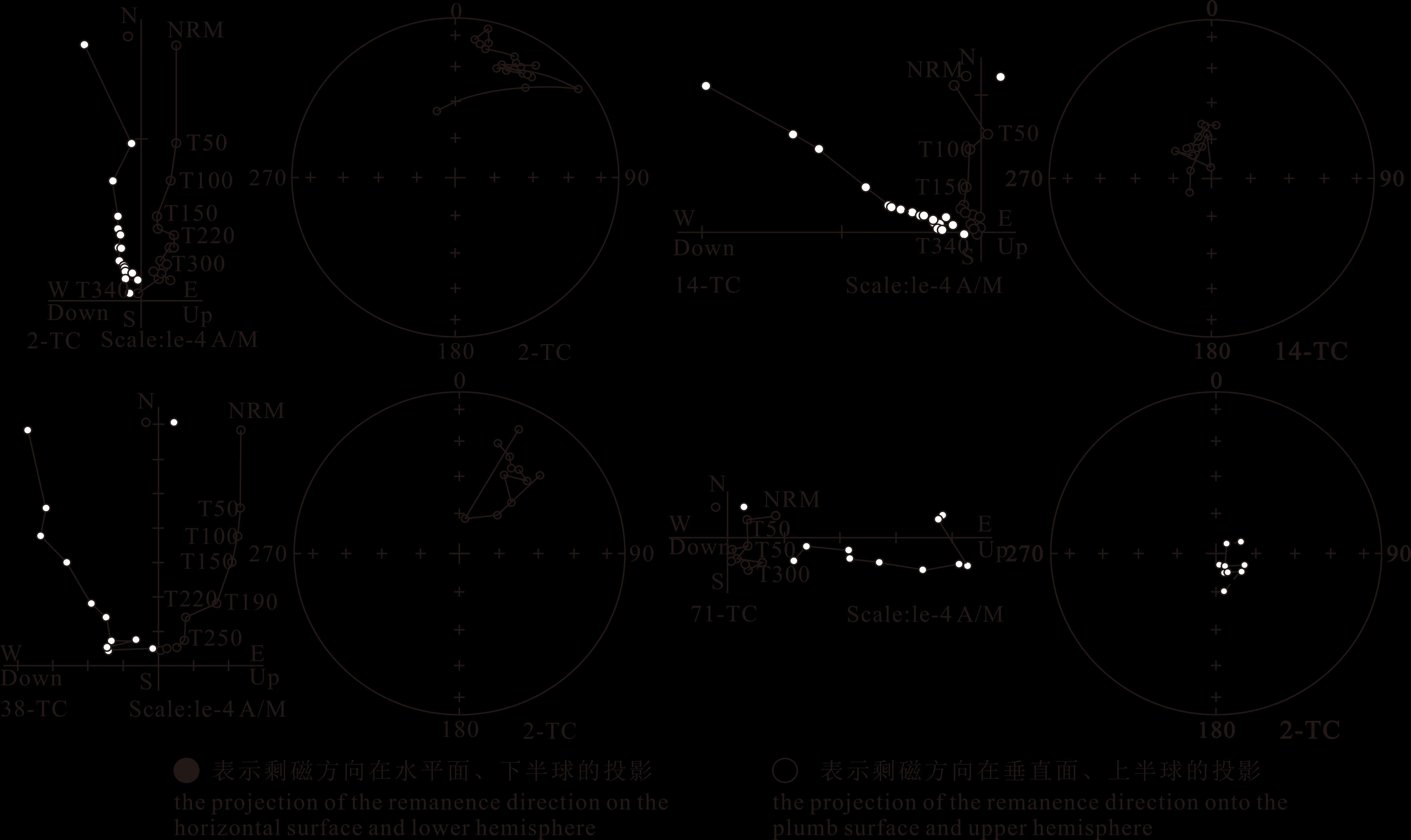
图6 山东平邑盆地PYZK01钻孔岩芯代表样品热退磁的Z矢量图和赤平投影图
Fig. 6 Orthogonal projections and equal—area stereographic projections of selected samples in the Drill PYZK01 in the Pingyi Basin, Shandong Province
综合上述生物地层分析鉴定结果,PYZK01钻孔的地层属于卞桥组一段,且跨卞桥组一段上下亚段,其时代可基本划分为如下情况:0~12.25 m地层时代为古近纪,37.8~60 m地层时代为晚白垩世最晚期。12.25~37.8 m中由于所采样品未分析出化石,具体地层时代暂时无法确认,但可以确定的是该段地层时代是晚白垩世—古近纪过渡段,即白垩系—古近系界线(KPB)应存在于该段(图2)。
3 磁性地层特征
磁性地层学是利用岩石剩余磁性纪录地磁场变化特征解决地层问题的一门科学,是进行地层多重划分对比研究的重要方法之一(杨振宇,2002)。近年来,磁性地层学在我国陆相沉积物定年方面发挥了重要作用,尤其是对于一些缺乏同位素定年材料的地层,磁性地层学与生物地层学相结合成为建立高精度地层年代框架的有效手段(孙知明等,2004;邓胜徽等,2015;吴百灵等,2018)。
为进一步详细研究平邑盆地KPB的准确位置,本次工作对PYZK01钻孔进行了磁性地层学研究。采样工作在山东省地质科学研究院岩芯库进行,在钻孔岩芯上直接采集,用专用电钻获取直径2.54 cm的圆柱状岩芯385块,采样密度即样品间隔为0.1~0.3 m,编号为SP1-1~SP1-385,现场标注记录后封存装箱,并送往实验室。测试工作在中国地质科学院地质力学研究所古地磁实验室完成。
3.1 剩磁测试与分析
本次对所有385块样品利用美制TD-48热退磁炉进行热退磁处理。首先对80余块样品进行先导样退磁,温度间隔为:NRM、100、180、240、300、350、400、440、480、510、540、560℃,并将各退磁后样品开展剩磁测试,岩石剩磁都是在美制2G-755超导磁力仪上进行的。考虑到样品绝大多数为极弱的剩余磁化强度,并且多数到350度后达到仪器的临界值,因此,其余样品的退磁温度间隔为:NRM、50、100、150、190、220、250、280、300、320、340℃,部分样品剩磁较强时,可继续开展如下温度段的退磁360、380、400、420、440、460、480℃。

图7 山东平邑盆地PYZK01钻孔岩芯第二类代表样品的Z矢量图和赤平投影图
Fig. 7 Orthogonal projections and equal—area stereographic projections of the second type selected samples in the Drill PYZK01 in the Pingyi Basin, Shandong Province
样品的剩磁组分分析均采用国际上通用的Enkin编制的古地磁软件包进行主向量分析。经过退磁测试,古地磁测试数据表现为如下3种情况:①样品能直接分离出较可靠的古地磁线性分量,其代表样品的正交Z矢量投影图(图6);②样品不能直接分离出可靠的古地磁分量,但是可以根据重磁化大圆弧判断出正、负极性,该类样品中的低温分量如果校准到现代地磁场方向,样品的剩磁方向通常沿着大圆弧从现代地磁场方向逐渐趋向于该样品的原生剩磁方向(图7)。从图可以看出,样品的剩磁倾角已经变化,磁倾角为负倾角。因此,我们可以推测这类样品的极性为反向极性;③第三种样品由于数据太差或者重磁化大圆弧太短,不能判断其方向变化趋势,因此这类样品被舍弃,没有用于建立磁极性柱。
3.2 磁性地层柱的建立
全部样品测试后的剩磁数据,均经主向量分析,获得了每个样品的特征剩磁方向或重磁化大圆弧,由于平邑卞桥镇古近纪地层整体上有10°~20°的倾斜,且钻孔岩芯无法进行水平方向定位,因此特征剩磁的磁偏角无地质意义,故用样品的磁倾角来确定其磁极性,然后再根据样品的真厚度,绘制出钻孔的磁倾角或根据重磁化大圆弧结果推测出的磁倾角随深度变化曲线。在建立钻孔岩芯柱的磁极性变化时,舍弃了连续正极性带中的单个负极性样品和连续负极性带中的单个正极性样品,以避免在样品的采集、测试过程中出现的误差给古地磁结果带来的影响。在此基础上,编制了PYZK01钻孔磁极性序列(图8)。
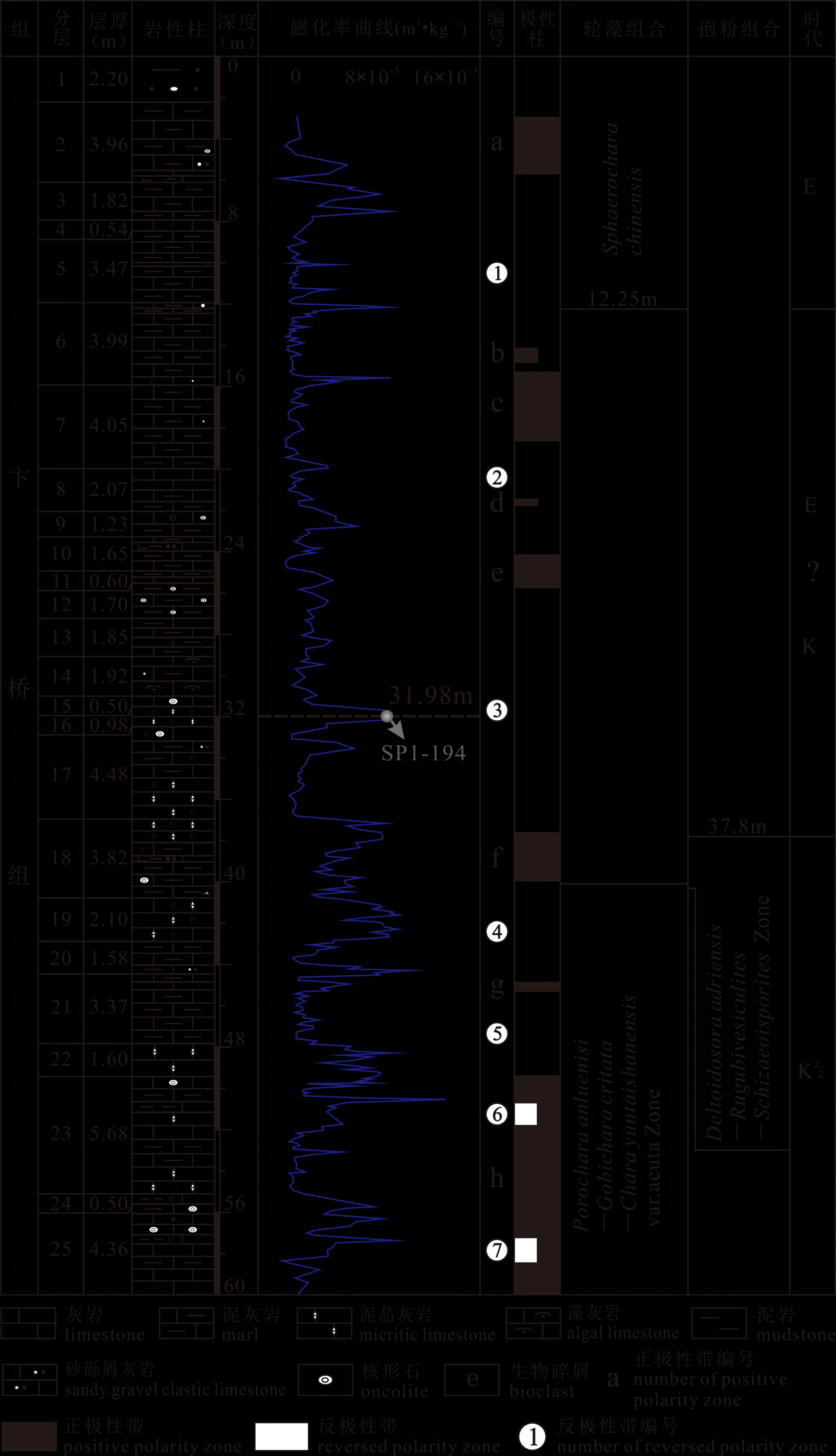
图8 山东平邑盆地PYZK01钻孔磁性特征与古生物化石组合
Fig. 8 Magnetic characteristics and paleontological fossil assemblage in the Drill PYZK01 in the Pingyi Basin, Shandong Province
可以看出,PYZK01钻孔岩芯共记录了8个正极性带和7个反极性带,由顶到底分别为:2.93~5.68 m为正极性带a;5.68~15.32 m为反极性带①,其中14.15~14.8 m夹1个正极性带b;15.32~18.65 m为正极性带c;18.65~24.15 m为反极性带②,其中21.45~21.74 m夹1个正极性带d;24.15~25.7 m为正极性带e;25.7~37.6 m为反极性带③;37.6~39.9 m为正极性带f;39.9~44.85 m为反极性带④;44.85~45.3 m为正极性带g;45.3~49.4 m为反极性带⑤;49.4~60 m为正极性带h,其中50.7~51.8 m、57.25~58.5 m夹2个反极性带⑥和⑦(图8)。
3.3 对比方案
根据PYZK01钻孔的生物地层研究结果,并将其与磁性柱状图叠合可发现,反极性带①中下部位置以浅确定为古近纪,正极性带f靠近顶部位置及其以深确定为晚白垩世最晚期,而其中间部位为晚白垩世—古近纪过渡段。
根据国际标准的磁极性年代柱(Gradstein et al., 2004)可知,白垩纪/古近纪界线位于C29极性带中反极性带的中部。结合PYZK01钻孔磁性地层极性分布特征以及生物地层年代结果,提出了本磁性地层柱与国际标准的磁极性年代柱的三种对比方案A、B、C(图9),而根据研究团队反复讨论,本文采纳了相对合理的一种对比方案A,即:将白垩纪/古近纪界线置于PYZK01钻孔反极性带③的中部(图9)。其它两种对比方案B和C因其与古生物化石分析的结果偏差较大而舍弃。
那么,PYZK01钻孔磁性地层柱与国际标准的磁极性年代柱的对应关系分别为:正极性带a、反极性带①分别对应C27的正、反极性带;正极性带b和c、反极性带②分别对应C28的正、反极性带;正极性带e、反极性带③分别对应C29的正、反极性带;正极性带f、反极性带④⑤分别对应C30的正、反极性带;正极性带h对应C31的正极性带。
4 岩芯界线位置探讨
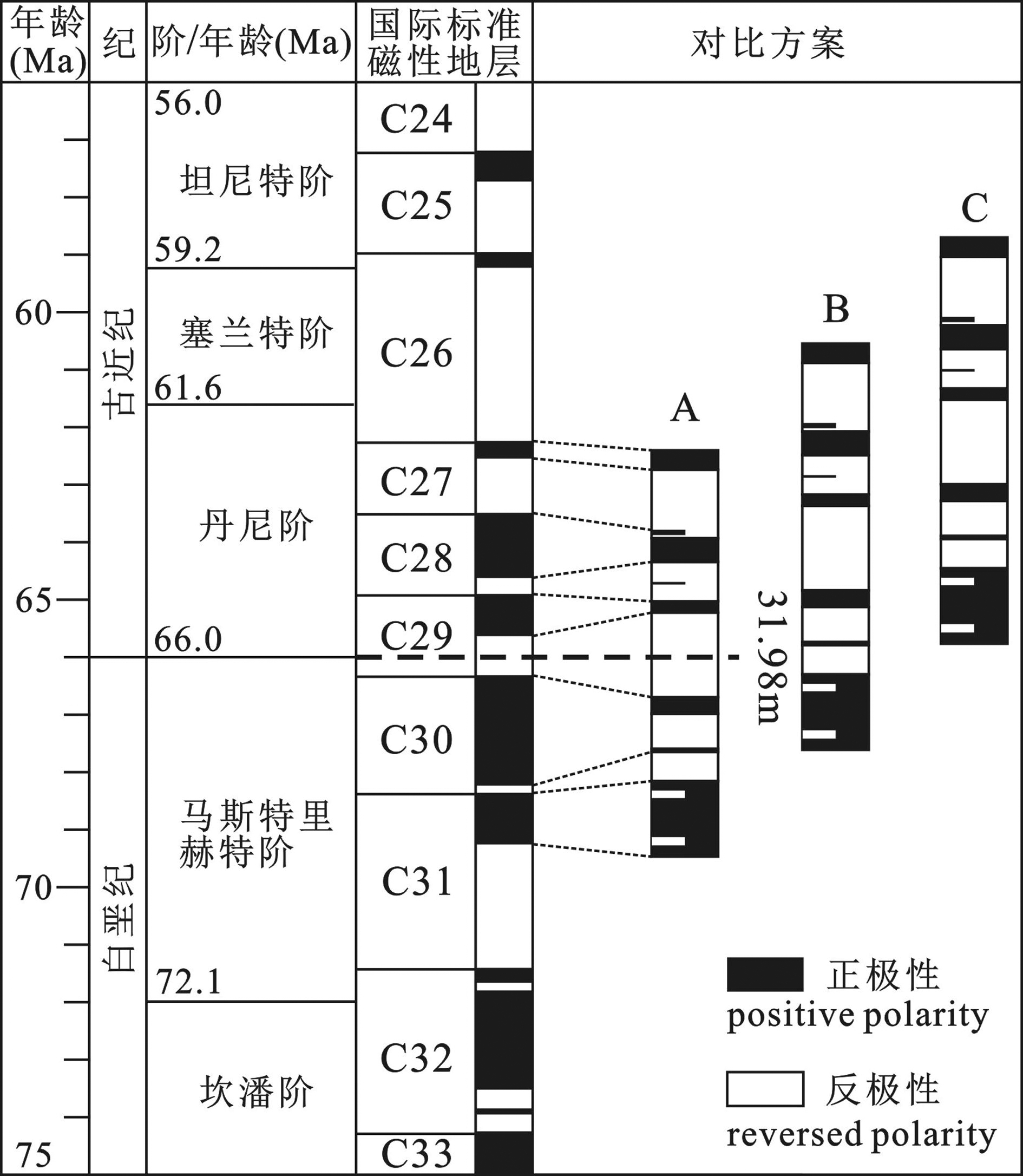
图9 山东平邑盆地PYZK01钻孔磁极性序列与国际标准极性年表对比方案
Fig. 9 Comparison plan between the magnetic polarity sequences of the Drill PYZK01 in the Pingyi Basin and the Geomagnetic Polarity Time Scale
以盆内和近源沉积物为主湖相碳酸盐岩对气候变化和陆源沉积物输入反应敏感,其特征随沉积环境变化差异明显(刘圣乾,2018)。根据以往研究显示,卞桥组的湖相灰岩以各类生物成因为主,特别是钙质微生物起到重要作用(徐宝政,1982;管守锐等,1985;李熙喆等,2000;唐鑫萍等,2011,2012;张矿明等,2013;杜圣贤等,2016)。从本钻孔岩性特征和沉积环境看,整体以灰白色、灰紫色、肉红色灰岩、泥灰岩为主,指示干热古气候环境。但在岩芯中段以下出现了大量以黄绿色、灰绿色和灰黑色等还原色为主色调的藻灰岩、泥灰岩和泥晶灰岩,表明该段地层的湖水虽仍为碳酸钙饱和状态,但其浑浊度明显比其它层位偏高且偏深,特别是在31.57 m以上不再出现以灰黑色为代表的还原环境地层,说明本钻孔中段层位出现了比较明显的沉积环境和古气候的快速变化或突变事件,可能与白垩纪—古近纪之交的地质事件有关(图2)。
由前文可知,岩芯中12.25 m处发现中华球状轮藻Sphaerochara cf. chinensis (Huang et Xu),表明0~12.25 m地层时代最早为古近纪;40.03~58.40 m处的轮藻化石组合Porochara anluensis—Chara yuntaishanensis var. acuta —Turbochara specialis表明40.03 m以深地层时代确定为晚白垩世最晚期,同时37.8~40.3 m处的孢粉组合Deltoidospora adriensis—Rugubivesiculites—Schizaeoisporites以及37.8~57.5 m处的腹足类化石也进一步印证了这一点。因此,可以确认PYZK01钻孔中存在白垩纪/古近纪界线,并通过生物地层将其限定在了岩芯的12.25~37.8 m处(图2)。
结合所测的佟家庄北露头剖面生物特征,在该剖面第10层的31 m处采集的古生物化石样品分析出了大量孔轮藻化石,如安陆孔轮藻Porochara anluensis Z. Wang,为晚白垩世晚期典型分子,可以推断剖面该位置处往下层位的地层时代为晚白垩世晚期,可与钻孔40.03 m以深的地层对比(图10)。
通过磁性地层研究建立了岩芯磁性地层柱,并与国际标准的磁极性年代柱进行了对比。根据本文的对比方案,将岩芯界线范围进一步缩小,限制在了25.7~37.6 m的反极性带③中。此外,结合钻孔的磁化率曲线看,其整体变化并不是很明显,这可能与湖相灰岩的剩余磁化强度较弱有关。但以反极性带③为界仍可看出,其上部岩芯磁化率值整体明显低于下部岩芯磁化率值。同时,在反极性带③中部的过渡带,古地磁采样点SP1-194处(即孔深31.98 m处)出现了一次比较明显的磁化率曲线值的负漂现象(图8)。而根据进行的碳氧同位素所得的曲线看,在该采样点同样出现了较明显的同位素曲线波动(该成果将另撰文详细叙述)。
进一步结合钻孔岩芯看,该处上下层位沉积序列连续,并未出现任何沉积间断和缺失现象(图10a);岩性为含生物碎屑砂砾屑泥晶灰岩,新鲜岩芯呈深灰黑色,氧化后呈深灰色。从31.98 m处的岩石薄片鉴定结果看,其镜下呈粒屑结构,花斑状构造,主要由团粒状泥晶方解石、黏土矿物和少量石英、不透明矿物组成,局部可见少量生物碎屑,是典型的内碎屑泥灰岩,且泥质含量较高(图10b、c)。
综合上述探讨可认为,平邑盆地PYZK01钻孔中存在白垩纪/古近纪界线(KPB),其位置基本确认在该钻孔岩芯古地磁采样点SP1-194,即孔深31.98 m处(图9、图10b),相当于卞桥组一段内部。
5 结论及建议
(1)平邑盆地卞桥组为一套典型、完整、连续的陆相碳酸盐岩湖相沉积,是进行非海相KPB研究的理想地层单元。

图10 山东平邑盆地PYZK01钻孔白垩纪/古近纪界线附近钻孔岩芯和界线在钻孔中的位置示意图
Fig. 10 The drill core nearby the Cretaceous—Paleogene boundary of the Drill PYZK01 and the schematic of the KPB position in the Drill
(2)通过对平邑卞桥镇佟家庄北PYZK01钻孔的生物地层研究,获得了丰富的轮藻、孢粉等微体古生物化石,根据其分布特征等建立了1个Porochara anluensis—Chara yuntaishanensis var. acuta—Turbochara specialis轮藻化石组合,1个Deltoidospora adriensis—Rugubivesiculites—Schizaeoisporites孢粉化石组合。根据化石在钻孔上的分布位置,白垩系—古近系界线(KPB)应存在于12.25~37.8 m之间。
(3)通过对平邑卞桥镇佟家庄北PYZK01钻孔的磁性地层研究,确立了8个正极性带和7个反极性带,编制了PYZK01钻孔磁性地层柱状。结合生物地层和磁性地层,提出了与国际标准的磁极性年代柱的对比方案。
(4)通过研究结果的探讨,初步认为PYZK01钻孔中的白垩纪/古近纪界线(KPB)位于孔深31.98m处,卞桥组一段内部。
(5)白垩纪/古近纪界线(KPB)研究是综合性课题,本次工作所运用的手段方法为KPB研究提供了新的、丰富的材料支撑。要精确确定平邑盆地白垩纪/古近纪界线,建立非海相白垩系—古近系界线层型,尚需新理论、多学科交叉实践,新方法、多手段综合运用。
致谢:古生物化石分析鉴定由中国科学院南京地质古生物研究所卢辉楠教授、王启飞研究员、曹美珍研究员、杨宁工程师、季兴开工程师等完成,古地磁样品测试由首都师范大学杨振宇教授团队完成,在此表示衷心感谢。同时,对《中国地质》郝梓国研究员的指导深表谢意。此外,对本文审稿人提出的评审意见和有益建议以及编辑们负责细致的工作,在此一并表示感谢。
(The literature whose publishing year followed by a “&” is in Chinese with English abstract; The literature whose publishing year followed by a “#” is in Chinese without English abstract)
陈丕基, 施泽龙, 叶宁, 叶得泉. 1998. 松花江动物群与东北白垩系地层序列. 古生物学报, 37(3): 380~385.
陈丕基, 万晓樵, 曹流. 2008. 中国陆相白垩系富饶阶研究进展. 见: 王泽九、黄志高主编. 中国主要断代地层建阶研究. 北京: 地质出版社: 65~73.
陈丕基, 万晓樵, 刘耕武, 曹美珍, 王启飞, 曹流, 李罡, 王亚琼. 2012. 富饶阶的时代归属. 地层学杂志, 36(4): 766~773.
邓胜徽, 王思恩, 杨振宇, 卢远征, 李鑫, 胡清月, 安纯志, 席党鹏, 万晓樵. 2015. 新疆准噶尔盆地中、晚侏罗世多重地层研究. 地球学报, 36(5): 559~574.
杜圣贤, 刘凤臣, 陈军, 高黎明, 宋香锁, 陈诚, 田兴磊, 张增奇, 刘书才. 2019. 山东平邑盆地晚白垩世—古新世生物地层及白垩系/古近系界线研究. 地质学报, 93(3): 1~18.
杜圣贤, 卢辉楠, 刘书才, 杨宁, 高黎明, 冯志平, 宋香锁, 刘凤臣. 2013. 山东平邑盆地晚白垩世孢粉化石. 微体古生物学报, 30(4): 379~388.
杜圣贤, 王启飞, 宋香锁, 季兴开, 刘凤臣, 陈梅. 2015. 山东平邑盆地古新世孢粉组合及其古气候意义. 微体古生物学报, 32(4): 419~429.
杜圣贤, 于深洋, 宋香锁, 刘凤臣, 陈军, 陈诚, 李越. 2016. 山东费县白垩纪末期卞桥组的湖相灰岩. 微体古生物学报, 33(4): 444~451.
管守锐, 白光勇, 狄明信. 1985. 山东平邑盆地下第三系官庄组中段碳酸盐岩沉积特征及沉积环境. 华东石油学院学报(自然科学版), 9(3): 9~20.
关绍曾, 庞其清, 萧宗正. 1997. 山东平邑盆地始新世介形类. 微体古生物学报, 14(3): 321~340.
黄仁金. 1988. 广东南雄盆地白垩系与第三系界线及轮藻化石. 古生物学报, 27(4): 457~474.
拉塞尔D A, 拉塞尔D E, 斯威特A R. 1993. 关于南雄盆地K/T界线地层序列的几个问题. 古脊椎动物学报, 31(2): 139~145.
李曼英. 1989. 广东南雄盆地古新世早期孢粉组合. 古生物学报, 28(6): 741~750.
李莎, 高琴琴, 张翼翼, 屈海英, 王曼艳, 万晓樵. 2013. 松辽盆地“松科1井(北孔)”晚白垩世晚期至古新世早期轮藻化石组合. 微体古生物学报, 30(1): 1~6.
李莎, 王启飞, 张羽, 张海春. 2015. 山东平邑盆地K/Pg界线附近轮藻植物群. 中国古生物学会第28届学术年会论文摘要集: 177.
李守军, 郑德顺, 蔡进功, 杨永红, 孙锡文, 杨品荣. 2003. 鲁北和鲁西南地区古近纪盆地沉积特征与控制因素探讨. 地质论评, 49(3): 225~232.
李伟同, 刘耕武, Dennis R B, 曹卫生, 陈钦保, Don B. 2010. 湖北当阳陆相白垩系—古近系界线层型问题值得深入研究. 地层学杂志, 34(2): 187~206.
李伟同. 1985. 关于湖北江汉盆地跑马岗组的时代的新认识. 科学通报, 30: 855~857.
李伟同. 2003. 中国当阳跑马岗组白垩—古近系界线附近的轮藻组合. 微体古生物学报, 20(2): 183~186.
李熙哲, 管守锐, 谢庆宾, 王泽成. 2000. 平邑盆地下第三系官中段核形石成因分析. 岩石学报, 16(2): 262~268.
凌秋贤, 张显球, 林建南. 2005. 南雄盆地白垩纪—古近纪地层研究进展, 地层学杂志, 29(B11): 596~601.
刘耕武, Dennis R B, 李伟同, Don B. 2009. 北美西部陆相白垩系—古近系界线孢粉学特征简介——兼评中国东部白垩系—古近系界线研究. 地层学杂志, 33(1): 18~34.
刘牧灵. 1983. 黑龙江富饶地区晚白垩世晚期至古新世孢粉组合. 中国地质科学院沈阳地质矿产研究所所刊, 7: 99~132.
刘圣乾. 2018. 东营凹陷西部沙四上亚段湖相碳酸盐岩沉积特征研究. 北京, 中国地质大学(北京): 115~143.
刘云, 王宗哲. 1986. 广东南雄盆地白垩系—第三系界线地层岩性特征及环境分析. 地层学杂志, 10(3): 190~203.
曲日涛, 杨景林, 王启飞. 2006. 鲁西南地区官庄群的地层对比及时代讨论. 地层学杂志, 30(4): 356~365.
戎嘉余, 李建国, 张海春, 朱学剑. 2003. 全球已批准的和潜在的层型剖面和点位(GSSPs). 地层学杂志, 23(1): 11~18.
孙革, 全成, 孙春林, 孙跃武, 雒昆利, 吕建生. 2005. 黑龙江嘉荫乌云组地层划分及时代的新认识. 吉林大学学报(地球科学版), 35(2): 137~142.
孙革, 孙春林, 董枝明, 孙跃武, 吕建生, 熊宪政, 周忠立, 余福林, 邢玉玲, 全成, Akhmetiev M A, Ashraf A R, Bugdaeva E, Dilcher D L, Golovneva L, Johnson K, Kezina T, Kodrul T, Okada H. 2003. 黑龙江嘉荫地区白垩纪—第三纪界线初步观察. 世界地质, 22(2): 8~14.
孙革, 孙春林, 孙跃武, 杨惠心, 陈跃军. 2013. 黑龙江嘉荫K—Pg(K—T)界线研究进展. 中国古生物学会第十一次全国会员代表大会暨第27届学术年会论文摘要集: 177~178.
孙革. 2009. 黑龙江嘉荫晚白垩世生物群及陆相K—T界线研究进展. 中国古生物学会第十次全国会员代表大会暨第25届学术年会论文摘要集: 217~218.
孙孟蓉, 孙素英. 1982. 南雄盆地古新世的孢粉组合. 中国地质科学院地质研究所集刊, 5: 127~148.
孙知明, 杨振宇, 葛肖虹, 裴军令, 郭新传, 李伟民, 马志强, 徐树军. 2004. 柴达木盆地西北缘古近系磁性年代研究进展. 地质通报, 23(9~10): 899~902.
唐鑫萍, 黄文辉, 邓宏文, 张矿明, 刘佳期, 穆娜娜. 2011. 山东平邑盆地古近系湖相核形石的沉积环境分析. 现代地质, 25(3): 456~463.
唐鑫萍, 黄文辉, 邓宏文, 王文勇, 穆娜娜. 2012. 山东平邑盆地古近系湖相微生物碳酸盐岩形成机理. 古地理学报, 14(3): 355~364.
童永生, 李曼英, 李茜. 2002. 广东南雄盆地白垩系—古近系界线. 地质通报, 21(10): 668~674.
童永生, 张玉萍, 王伴月, 丁素因. 1976. 南雄盆地和池江盆地早第三纪地层. 古脊椎动物与古人类, 14(1): 16~25.
吴百灵, 邓成龙, 孔艳芬, 刘素贞, 孙蕗, 李仕虎, 葛俊逸, 王元, 金昌柱, 朱日祥. 2018. 甘肃陇中盆地会宁关公滩剖面磁性地层年代学研究. 地球物理学报, 61(4): 1390~1399.
吴其切, 杨文达, 胡存礼, 周全春, 刘海燕. 1984. 苏皖及邻区上白垩统与第三系的界限. 中国科学(B辑), (7): 645~657.
徐宝政. 1982. 山东平邑盆地早第三纪的核形石及其形成环境. 化工矿产地质, 2: 1~6.
杨恒仁, 蔡小礼, 徐文豪. 1989. 苏北盆地泰州组、阜宁组一段介形类组合特征及时代. 见: 江苏石油勘探局地质科学研究院、中国科学院南京地质古生物研究所著, 苏北盆地泰州组、阜宁组一段地层古生物. 南京: 南京大学出版社: 129~153.
杨景林, 徐健, 刘凤臣, 王睿, 沈一新. 2013. 平邑盆地固城组和卞桥组介形类动物群. 微体古生物学报, 30(2): 145~165.
杨振宇. 2002. 高精度地层划分对比的可靠方法—磁性地层学研究. 地质通报, 21(1): 45~47.
于学峰, 杜圣贤, 王启飞, 刘书才, 周丽, 刘凤臣, 卢辉楠, 陈诚. 2014. 山东平邑盆地晚白垩世介形类. 微体古生物学报, 31(4): 387~404.
余汶, 顾和林, 张显球. 1990. 广东南雄盆地晚自垩世—早第三纪非海相腹足类组合序列. 古生物学报, 29(2): 160~175.
张矿明, 黄文辉, 汪建辉, 曾婷婷, 唐鑫萍. 2013. 山东省平邑盆地古近系湖相核形石特征及环境意义. 沉积学报, 31(2): 259~268.
张显球, 李罡, 林建南, 凌秋贤. 2006a. 南雄盆地大塘白垩系—古近系界线层型剖面. 第十届古脊椎动物学学术年会论文集, 北京: 海洋地质出版社: 17~32.
张显球, 李罡. 2008. 广东南雄盆地罗佛寨群星的介形类动物群. 微体古生物学报, 25(1): 44~77.
张显球, 林建南, 李罡, 凌秋贤. 2006b. 南雄盆地大塘白垩系—古近系界线剖面研究. 地层学杂志, 30(4): 327~340.
张显球. 1992a. 南雄盆地上湖组的划分与对比. 广东地质, 7(1): 41~49.
张显球. 1987. 南雄盆地白垩—古近系地层划分及介形类化石组合序列. 中新生代地质学术讨论论文集, 北京地质出版社.
张显球. 1991. 从介形类动物群论南雄盆地白垩—第三系界线. 广东地质, 6(3): 61~72.
张显球. 1992b. 广东南雄盆地上湖组介形虫动物群及白垩—第三系界线. 古生物学报, 31(6): 678~720.
张增奇, 杜圣贤, 张尚坤, 卢辉楠, 刘书才, 高黎明, 宋香锁, 杨宁, 刘凤臣, 周丽, 陈诚, 陈军. 2014a. 山东平邑盆地官庄群有关地层的重新厘定. 地层学杂志, 38(1), 8~24.
张增奇, 刘明渭, 宋志勇, 张淑芳, 栾恒彦, 迟守祥, 徐立军, 赵光华, 高美霞, 迟培星, 艾宪森, 张成基. 1996. 山东省岩石地层, 全国地层多重划分对比研究(37). 武汉: 中国地质大学出版社.
张增奇, 张成基, 王世进, 刘书才, 王来明, 杜圣贤, 宋志勇, 张尚坤, 杨恩秀, 程光锁, 刘凤臣, 陈军, 陈诚. 2014. 山东省地层侵入岩构造单元划分对比意见. 山东国土资源, 30(3): 1~23.
赵资奎, 毛雪瑛, 柴之芳, 杨高创, 张福成, 严正. 2009. 广东南雄盆地白垩系—第三系(K/T)过渡时期地球化学环境变化和恐龙灭绝: 恐龙蛋化石提供的证据. 科学通报, 54(2): 201~209.
赵资奎, 毛雪瑛, 柴之芳, 欧阳宏, 佘德伟. 1998. 广东南雄盆地白垩系—第三系(K/T)交界恐龙蛋壳的铱丰度异常. 中国科学(D辑), 28(5): 425~430.
赵资奎, 严正. 2000. 广东南雄盆地白垩系—第三系界线剖面恐龙蛋壳稳定同位素记录: 地层及古环境意义. 中国科学(D), 30(2): 135~141.
赵资奎, 叶捷, 李华梅, 赵振华, 严正. 1991. 广东省南雄盆地白垩系—第三系交界恐龙绝灭问题. 古脊椎动物学报, 29(1): 1~20.
郑亚惠, 何承全. 1984. 苏北钦30井晚白垩世泰州组的孢粉学. 中国科学院南京地质古生物研究所丛刊, 8: 55~117.
Allan J A, Sanderson J O G. 1945. Geology of Red Deer and Rosebud sheets, Alberta. Research Council of Alberta, 13: 1~115.
Baltz E H, Ash S R, Anderson R Y. 1966. History of Nom enclature and stratigraphy of rocks adjacent to the Cretaceous—Tertiary boundary western San Juan Basin, New Mexico. United States Geological Survey, Professional Paper, 524: 1~23.
Braman D R, Sweet A R. 1991. Field guide to uppermost Cretaceous—Tertiary strata in southern Sask at chewan and Alberta. Event markers in Earth History, Field Trip, Calgary, Alberta: 55.
Chen Peiji, Shi Zhailong, Ye Ning, Ye Dequan. 1998&. Sungari biota and Cretaceous stratigraphic sequence of NE China. Acta Palaeontologica Sinica, 37(3): 380~385.
Chen Peiji, Wan Xiaoqiao, Cao Liu. 2008#. Research progress of continental Cretaceous Furaoan Stage in China. From: Wang Zejiu, Huang Zhigao. Study on establishmenting steps of the main division stratum in China. Beijing: Geological Publishing House: 65~73.
Chen Peiji, Wan Xiaoqiao, Liu Gengwu, Cao Meizhen, Wang Qifei, Cao Liu, Li Gang, Wang Yaqiong. 2012&. On the geological age of the Furaoan stage. Journal of Stratigraphy, 36(4):755~772.
Dale A Russell, Donald E Russell, Arthur R Sweet.1993&. The end of the dinosaurian era in the Nanxiong basin. Vertebrata PalAstatica, 31(20): 139~145.
de Oca C S, de Lange G J,Martinez-Ruiz F,Rodriguez-Tovara F J. 2018. Application of laser ablation-ICP-MS to determine high-resolution elemental profiles across the Cretaceous/Paleogene boundary at Agost (Spain). Palaeogeography, Palaeoclimatology, Palaeoecology, 497: 128~138.
Debey L B, Wilson G P. 2014. Mammalian femora across the Cretaceous—Paleogene boundary in eastern Montana. Cretaceous Research, 51: 361~385.
Deng Shenghui, Wang Sien, Yang Zhenyu, Lu Yuanzheng, Hu Qingyue, An Chunzhi, Xi Dangpeng, Wan Xiaoqiao. 2015&. Comprehensive study of the Middle—Upper Jurassic strata in the Jungger Basin, Xinjiang. Acta Geoscientica Sinica, 36(5): 559~574.
Du Shengxian, Liu Fengchen, Chen Jun, Gao Liming, Song Xiangsuo, Chen Cheng, Tian Xinglei, Zhang Zengqi, Liu Shucai. 2019&. The Cretaeous—Paleocene biostratigraphy and boundary in the Pingyi Basin, Shandong province.
Du Shengxian, Lu Huinan, Liu Shucai, Yang Ning, Gao Liming, Feng Zhiping, Song Xiangsuo, Liu Fengchen. 2013&. Late Cretaceous sporo-pollen fossils of the Pingyi basin, Shandong Province. Acta Micropalaeontologica Sinica, 30(4): 379~388.
Du Shengxian, Wang Qifei, Song Xiangsuo, Liu Fengchen, Chen Mei. 2015&. Paleocene sporo-pollen fossils of the Pingyi basin, Shandong Province, China. Acta Micropalaeontologica Sinica, 32(4): 419~429.
Du Shengxian, Yu Shenyang, Song Xiangsuo, Liu Fengchen, Chen Jun, Chen Cheng, Li Yue. 2016&. Lacustrine limestones of the Bianqiao Formation (Maastrichtian, latest Cretaceous) from Feixian, Shandong province, east China. Acta Micropalaeontological Sinica, 33(4): 444~451.
Eberth D A, O’Connell S C. 1995. Notes on changing paleoenvironments across the Cretaceous—Tertiary boundary (Scollard ormation) in the Red Deer River Valley of southern Alberta. Bulletin of Canadian Petroleum Geology, 43: 44~53.
Fastovsky D E. 1987. Paleoenvironments of vertebrate bearingst rata during the Cretaceous—Paleogene transition, eastern Montana and western North Dakota. Palaios, 2: 282~295.
Gradstein F M, Ogg J G, Smith A G. 2004. A Geologic Time Scale 2004. United Kingdom: Cambridge University Press.
Guan Shaozeng, Pang Qiqing, Xiao Zongzheng. 1997&. The Early Eocene non-marine ostracods from Pingyi basin, Shandong. Acta Micropalaeontologica Sinica, 14(3): 321~340.
Guan Shourui, Bai Guangyong, Di Mingxin. 1985&. Sedimentary chearacteristics and environment of carbonate rocks in the middle member of the Guanzhuang Formation of Lower Tertiary in the Pingyi Basin of Shandong province. Journal of East China Petroleum Institute (Natural Science Edition). 9(3): 9~20.
Huang Renjin. 1988&. Charophytes of Nanxiong basin, Guangdong and its Cretaceous—Tertiary boundary. Acta Palaeontologica Sinica, 27(4): 457~474.
Hunter J P, Archibald J D. 2002. Mammals from the end of the age of dinosaurs in North Dakota and southeastern Montana, with a reappraisal of geographic differentiation among Lancian mammals. Geological Society of America Special Pape, 361: 191~261.
Hunter J P, Harman J H, Krause D W. 1997. Mammals and mollusks across the Cretaceous—Tertiary boundary from Makoshika State Park and vicinity (Williston Basin), Montana. Contributionsto Geology, University of Wyoming, 32: 61~114.
Jerzykiewicz T, McLean J R. 1980. Lithostratigraphical and sedimentological framework of coalbearing Upper Cretaceous and Lower Tertiary strata, Coal Valley area, central Alberta Foothills. Geological Survey of Canada, 79 (12): 1~47.
Kauffman E G. 1986. High-Resolution Event Stratigraphy, Regional and Global Cretaceous Bio-Events. Walliser O. Global Bio-Events. Berlin: Springer-Verlag: 279~335.
Koch E, Blissenbach E. 1960. Die gefalteten oberkretazisch tertiären Rotschichten im Mittel-Ucayali Gobiet, Ostperu. Beih. Geol. Jb, 43: 1~103.
Li Baofang, Dawson F M. 1988. Stratigraphic framework and depositional setting, Judy Creek coal field, northern Alberta. Geological Survey of Canada, 88 (1D): 121~128.
Li Manying. 1989&. Sporo-pollen from Shuanghu Formation of Early Paleocene in Nanxiong basin, Guangdong. Acta Palaeontologica Sinica, 28(6):741~750.
Li Sha, Gao Qinqin, Zhang Yiyi, Qu Haiying, Wang Manyan, Wan Xiaoqiao. 2013&. Late Late Cretaceous—Early Paleocene charophytes from the Songliao basin, North China: SK1(N) core. Acta Palaeontologica Sinica, 30(1): 1~6.
Li Sha, Wang Qifei, Zhang Haichun, Lu Huinan. 2015. Charophytes from the Cretaceous—Paleogene transition in the Pingyi Basin (Eastern China) and their Eurasian correlation. Cretaceous Research, 59 (2016): 179~200.
Li Sha, Wang Qifei, Zhang Yu, Zhang Haichun. 2015#. Flora near K/Pg boundary in Pingyi Basin, Shandong province. Abstracts from the 28th annual meeting of the Palaeontological Society of China: 177.
Li Shoujun, Zheng Deshun, Cai Jingong, Yang Yonghong, Sun Xiwen, Yang Pinrong. 2003&. Sedimentary chaiacteritics and controlling factors of basins in the North Shandong and Southwest Shandong in Paleogene. Geological Review, 49(3): 225~232.
Li Weitong, Liu Gengwu, Dennis R. Braman, Cao Weisheng, Chen Qinbao, Don Brinkman. 2010&. A proposal to further incestigate the Cretaceous—Paleogene boundary section at Dangyang Hubei province. Journal of Stratigraphy, 34(2): 187~206.
Li Weitong. 1985#. New advance of the age of the Paomagang formation in Jianghan basin, Hubei. Chinese Science Bulletin, 30(11): 855~857.
Li Weitong. 1998. Les charophytes dela Formation Paomagang de Dangyang (Chine): la limite Cretace/ Tertiaire ages des Intertraps du Deccan a Nagpur, Indeetde lunion de l’Inde a l’Asi e.Editions de L’Indu strie Petroliere, Bei jing, Chine: 1~22.
Li Weitong. 2003&. Charophyte assemblages around Cretaceous—Paleogene boundary from the Paomagang Formation in Dangyang (China). Acta Micropalaeontologica Sinica, 20(2): 183~186.
Li Weitong. 2006. Dangyang section: poential candidate for continental stratotype of Cretaceous—Paleogene boundary (KPB). In: Yang Qun, Wang Yongdong, Weldon E A. eds. Ancient Life and Modern Approaches——Abstract of the Second International Paleontological Congress. Hefei: University of Science and Technology of China Press: 250~251.
Li Xizhe, Guan Shourui, Xie Qingbin, Wang Zecheng. 2000&. The oncoids genesis in the Middle Member of the Guanzhuang Formation of Eocene in Pingyi Basin. Acta Petrologica Sinica, 16(2): 261~268.
Ling Qiuxian, Zhang Xianqiu, Lin Jiannan. 2005&. New advance in the study of the Cretaceous and Paleogene strata of the Nanxiong basin. Journal of Stratigraphy, 29(B11): 596~601.
Liu Gengwu, Dennis R. Braman, Li Weitong, Don Brinkman. 2009&. Playnostratigraphic charateristics of Cretaceous—Paleogene boundary of western north America and review on searching for Cretaceous—Paleogene boundary in eastern China. Journal of Stratigraphy, 33(1): 18~34.
Liu Muling. 1983&.The Late Upper Cretaceous to Palaeocene spore pollen assemblages from the Furao area, Heilongjiang province. Bulletin of the Shenyang Institute of Geology and Mineral Resources, 7: 99~132.
Liu Shengqian. 2018&. Sedimentary characteristics of lacustrine carbonates in the upper fourth member of Shahejie formation (Es4s), western Dongying Depression. Beijing, China University of Geosciences (Beijing): 115~143.
Liu Yun, Wang Zongzhe. 1986&. Lithologic character and environmental analysis of Cretaceous—Tertiary stratum in Nanxiong basin, Guangdong. Journal of Stratigraphy, 10(3): 190~203.
Longrich N R, Bhullar B A S, Gauthier J A. 2012. Mass extinction of lizards and snakes at the Cretaceous—Paleogene boundary. Proceedings of the National Academy of Sciences, 109(52): 21396~21401.
Longrich N R, Tokaryk T, Field D J. 2011. Mass extinction of birds at the Cretaceous—Paleogene (K—Pg) boundary. Proceedings of the National Academy of Sciences, 108(37): 15253~15257.
Martin J E, Vincent P, Tacail T, Khaldoune F, Jourani E, Bardet N, Balter V. 2017. Calcium Isotopic Evidence for Vulnerable Marine Ecosystem Structure Prior to the K/Pg Extinction. Current Biology, 27: 1641~1644.
Mountjoy E W. 1967. Upper Cretaceous and Tertiary stratigraph, northern Yukon Territory and northwestern District of Mackenzie. Geological Survey of Canada, 66(16): 70.
Mull C G, Houseknecht D W, Bird K J. 2004. Revised Cretaceousand Tertiary strati graphic nomen clature in the Colville Basin, northern Alaska. United States Geological Survey, Professional, 1673: 26.
Norris D K, Hopkins W S Jr. 1977. The geology of the BonnetPlume Basin, Yuk on Territory. Geological Survey of Canada, 76(8): 20.
Norris G. 1967. Spores and pollen from the Lower Colorado Group (Albian?—Cenomanian) of central Alberta. Palaeontographica, 120: 72~115.
Paul R R, Courtney J S, Mark A R, Stephen S, Loyc V, Kanchean P. 2015. State shift in Deccan volcanism at the Cretaceous—Paleogene boundary, possibly induced by impact. Science, 350(6256): 76~78.
Pierce R L. 1961. Lower Upper Cretaceous plant microfossils from Minnesota. Minn. Geol. Surv., Bull., 42:1~86.
Qu Ritao, Yang Jinglin, Wang Qifei, Chang Guozhen. 2006&. Stratigraphic division and correlation of the Guanzhuang group in southwest Shandong. Journal of Stratigraphy, 30(4): 356~365.
Raup D M, Sepkoski J J Jr. 1986. Periodic extinction of families and genera. Science, 241: 94~96.
Remane J, Keller G, Hardenbol J, Ben Haj Ali M. 1999. International workshop on Cretaceous—Paleogenetransitions in Tunisia: The El Kef stratotype for the Cretaceous—Paleogene boundary reconfirmed. Episodes, 22(1): 47~48.
Renne P R, Deino A L, Hilgen F J, Kuiper K F, Mark D F, Mitchell W S, Morgan L E, Mundil R, Smit J. 2013. Time scales of critical events around the Cretaceous—Paleogene boundary. Science, 339(6120): 684~687.
Rong Jiayu, Li Jianguo, Zhang Haichun, Zhu Xuejian. 2003&. Overview of global boundary stratotype sections and points (GSSPs). Journal of stratigraphy, 23(1): 11~18.
Saito T, Yamanoi T, Kaiho K. 1986. End-Cretaceous devastation of terrestrial flora in the boreal Far East. Nature, 323: 253~255.
Sosa-Montes de Oca, Rodriguez-Tovar, Martinez-Ruiz, Paoo Monaco. 2017. Paleoenvironmental conditions across the Cretaceous—Paleogene transition at the Apennines sections (Italy): An integrated geochemical and ichnological approach. Cretaceous Research, 71: 1~13.
Sun Ge, Quan Cheng, Sun Chunlin, Sun Yuewu, Luo Kunli, Lü Jiansheng. 2005&. Some new knowledge on subdivisions and age of Wuyun Formation in Jiayin of Heilongjiang, China. Journal of Jilin University (Earth Science Edition), 35(2): 137~142.
Sun Ge, Sun Chunlin, Dong Zhiming, Sun Yuewu, Lv Jiansheng, Xiong Xianzheng, Zhou Zhongli, Yu Fulin, Xing Yuling, Quan Cheng, Akhmetiev M A, Ashraf A R, Bugdaeva E, Dilcher D L, Golovneva L, Johnson K, Kezina T, Kodrul T, Okada H. 2003&. Preliminary Study of the Cretaceous—Tertiary Boundary in Jiayin of the Heilongjiang River Area of China. Global Geology, 22(2): 8~14.
Sun Ge, Sun Chunlin, Sun Yuewu, Yang Huixin, Chen Yuejun. 2013#. Research progress of K—Pg (K—T) boundary in Jiayin, Heilongjiang. Abstract volume of the 11th national members’ congress of Palaeontological Society of China and the 27th Annual Conference: 177~178.
Sun Ge. 2009#. Research progress of Late Cretaceous biota and K—T boundary in Jiayin, Heilongjiang. Abstract volume of the 10th national members’ congress of Palaeontological Society of China and the 25th annual conference: 217~218.
Sun Huirong, Sun Suying. 1982&. The Paleocene Palynological assemblages from Nanxiong basin, Guangdong. Bulletin of The Institute of Geology, Chinese Academy of Geological Sciences, 5: 127~148.
Sun Zhiming, Yang Zhenyu, Ge Xiaohong, Pei Junling, Guo Xinchuan, Li Weimin, Ma Zhiqiang, Xu Shujun. 2004&. Advances in the study of Paleogene magnetostratigraphy on the northwestern margin of the Qaidam basin. Geological Bulletin of China, 23(9~10): 899~902.
Suzuki Shigeyuki, Sun Ge, Ulrich Knittel, Iwano Hideji. 2011. Radiometric Zircon Ages of a Tuff Sample from the Baishantou Member of Wuyun Formation, Jiayin: A Contribution to the Search for the K—T Boundary in Heilongjian River Area, China. Acta Geologica Sinica(English Edition), 85(6): 1755~6724.
Tang Xinping, Huang Wenhui, Deng Hongwen, Wang Wenyong, Mu Nana. 2012&. Formation mechanisms of the Paleogene lacustrine microbial carbonate rocks in Pingyi Basin, Shandong Province. Journal of Palaeogeography, 14(3): 355~364.
Tang Xinping, HuangWenhui, Deng Hongwen, Zhang Kuangming, Liu Jiaqi, Mu Nana. 2011&. Sedimentary environment of Paleogene lacustrine oncoids in Pingyi Basin, Shandong Province. Geoscience, 25(3): 456~463.
Tong Yongsheng, Li Manying, Li Qian. 2002&. The Cretaceous—Paleogene boundary in the Nanxiong basin, Guangdong Province. Geological Bulletin of China, 21(10): 668~674.
Tong Yongsheng, Zhang Yuping, Wang Banyue, Ding Suyin. 1976&. Early Tertiary strata of Nanxiong basin and Chijiang basin. Vertebrata Palasiatica. 14(1): 16~25.
Uliana M A, Mussacchio E A. 1978. Microfosiles calcareos no-marinos del Cretacico superior en Zampal, provincial de Mendoza, Argentina. Ameghiniana, 15(1/2): 111~135.
Vajda V, Raine J I, Hollis C J. 2001. Indication of global deforestation at the Cretaceous—Tertiary boundary by New Zealand fern spike. Science, 294: 1700~1702.
Wan Xiaoqiao, Zhao Jing, Scott W Rcott, Wang Pujun, Feng Zihui, Huang Qinghua, Xi Dangpeng. 2012. Late Cretaceous stratigraphy, Songliao Basin, NE China: SK1 cores. Palaeogeography, Palaeoclimatology, Palaeoecology, 385(1): 31~43.
Wilson G P. 2014. Mammalian extinction, survival, and recovery dynamics across the Cretaceous—Paleogene boundary in northeastern Montana, USA. Geological Society of America Special Papers, 503: 365~392.
Wu Bailing, Deng Chenglong, Kong Yanfen, Liu Suzhen, Sun Lu, Li Shihu, Ge Junyi, Wang Yuan, Jin Changzhu, Zhu Rixiang. 2018&. Magnetostrigraphy of the fluvio—lacustrine sequence on the Guangongtan section in Longzhong Basin, NW China. Chinese Journal of Geophysics, 61(4): 1390~1399.
Wu Qiqie, Yang Wenda, Hu Cunli, Zhou Quanchun, Liu Haiyan. 1982&. The boundary of Late Cretaceous and Paleogene in Jiangsu, Anhui and adjacent areas. Sciencein China (Series B), (7): 645~657.
Xu Baozheng. 1982#. The nucleated and their forming environment in Early Tertiary in Pingyi Basin, Shandong province. Chemcal and Mineral Geology, 2: 1~6.
Yang Hengren, Cai Xiaoli, Xu Wenhao. 1989#. The ostracods and the age of the Taizhou formation and the first section of the Funing formation in Subei basin. From: Jiangsu Exploration and Development Bureau Geological Research Institute, Chinese Academy of Sciences Nanjing Institute of Geology and Palaeontology. Stratigraphy and palaeontology of the Taizhou formation and the member of the Funing formation North Jiangsu basin. Nanjing: Nanjing University Press: 129~154.
Yang Jinglin, Xu Jian, Liu Fengchen, Wang Rui, Shen Yixin. 2013&. Ostracode faunas from the Gucheng and Bianqiao formation in Pingyi basin, Shandong. Acta Micropalaeontogical Sinic, 30(2): 145~165.
Yang Zhenyu. 2002#. Reliable method of high precision stratigraphic division and correlation——study on magnetic stratigraphy. Geological Bulletin of China, 21(1): 45~47.
Yu Wen, Gu Helin, Zhang Xianqiu. 1990&. Assemblage sequence of Late Cretaceous and Early Tertiary non-marine gastropods from Nanxiong basin, Guangdong. Acta Palaeontologica Sinica, 29(2): 160~175.
Yu Xuefeng, Du Shengxian, Wang Qifei, Liu Shucai, Zhou Li, Liu Fengchen, Lu Huinan, Chen Cheng. 2014&. Late Cretaceous ostracods from the Pingyi basin, Shandong Province, China. Acta Micropalaeontogical Sinica, 31(4): 387~404.
Zhang Kuangming, Huang Wenhui, Wang Jianhui, Zeng Tingting, Tang Xinping. 2013&. Characteristics and environmental significance of lacustrine oncolites in Paleogene Guanzhuang Formation in Pingyi Basin, Shandong Province in Eastern China. Acta Sedimentologica Sinica, 31(2): 259~268.
Zhang Xianqiu, Li Gang. 2008&. Ostracod faunas from the Luofozhai group in the Nanxiong basin of Guangdong Province, China. Acta Micropalaeontologica Sinica, 25(1): 44~77.
Zhang Xianqiu, Lin Jiannan, Li Gang, Ling Qiuxian. 2006a#. Strtum Model of the Cretaceous—Tertiary Boundary of Datang, Nanxiong basin, Guangdong, China. Proceedings of the Tenth Annual Meeting of the Chinese Society of Vertebrate Paleontology. Beijing: China Ocean Press: 17~32.
Zhang Xianqiu, Lin Jiannan, Li Gang, Ling Qiuxian. 2006a&. Non-marine Cretaceous—Paleogene boundary section at Datang of Nanxiong, northern Guangdong. Journal of Stratigraphy, 30(4): 327~340.
Zhang Xianqiu. 1987#. Stratigraphic Division and Ostracode Assemblage Sequence of Cretaceous—Paleogene in Nanxiong Basin. Collection of Academic Discussions of Mesozoic—Cenozoic Geology, Beijing: Geological Publishing House.
Zhang Xianqiu. 1991&. Discussion on the Cretaceous—Tertiary boundary in Nanxiong basin in the light of ostracod fauna. Guangdong Geology, 6(3): 61~72.
Zhang Xianqiu. 1992&. A study on ostracod fauna of Shanghu formation and Cretaceous—Tertiary boundary in Nanxiong basin, Guangdong. Acta Palaeontologica Sinica, 31(6): 678~720.
Zhang Xianqiu. 1992a&. Division and correlation of Shanghu formation in Nanxiong basin. Guangdong Geology, 7(1): 41~49.
Zhang Zengqi, Du Shengxian, Zhang Shangkun, Lu Huinan, Liu Shucai, Gao Liming, Song Xiangsuo, Yang Ning, Liu Fengchen, Zhou Li, Chen Cheng, Chen Jun. 2014a&. Reassessment of the Guanzhuang group in the Pingyi basin, Shandong. Journal of Stratigraphy, 38(1): 8~24.
Zhang Zengqi, Liu Mingwei, Song Zhiyong, Zhang Shufang, Luan Hengyan, Chi Shouxiang, Xu Lijun, Zhao Guanghua, Gao Meixia, Chi Peixing, Ai Xiansen, Zhang Chengji. 1996#. Lithostratigraphy of Shandong Province. Wuhan: China University of Geoscience Press.
Zhang Zengqi, Zhang Chengji, Wang Shijin, Liu Shucai, Wang Laiming, Du Shengxian, Song Zhiyong, Zhang Shangkun, Yang Enxiu, Cheng Guangsuo, Liu Fengchen, Chen Jun, Chen Cheng. 2014b&. Views on classification and contrast of tectonic units in strata in Shandong Province. Shandong Land and Resources, 30(3): 1~23.
Zhao Z K, Mao X Y, Chai Z F, Yang G C, Kong P, Ebihara M, Zhao Z H. 2002. A possible causal relationship between extinction of dinosaurs and K/T iridium enrichment in the Nanxiong Basin, South China: evidence from dinosaur eggshells. Palaeogeography, Palaeoclimatology, Palaeoecology, 178(1~2): 1~17.
Zhao Zikui, Mao Xueying, Chai Zhifang, Ou Ynaghong, She Dewei. 1998#. Iridium anomaly of dinosaur eggshell across the Cretaceous—Teritiary boundary (K/T) in Nanxiong basin, Guangdong Province. Science in China (Series D), 28(5): 425~430.
Zhao Zikui, Mao Xxueying, Chai Zhifang, Yang Gaochuang, Zhang Fucehng, Yan Zheng. 2009&. Geochemical environmental changes and dinosaur extinction during the Cretaceous—Paleogene (K/T) transition in the Nanxiong Basin, South China: Evidence from dinosaur eggshells. Chinese Science Bulletin, 54(2): 201~209.
Zhao Zikui, Yan Zheng. 2000#. Stable isotopic records of dinosaur eggshell across the Cretaceous—Teritiary boundary in Nanxiong basin, Guangdong Province: aignificance of stratigraphic and paleoenvironmental. Science in China (Series D), 30(2): 135~141.
Zhao Zikui, Ye Jie, Li Huamei, Zhao Zhenhua, Yan Zheng. 1991&. Extinction of the dinosaurs across the Cretaceous—Teritiary boundary in Nanxiong basin, Guangdong Province. Vertebrata Palasiatica, 29(1): 1~20.
Zheng Yahui, He Chengquan. 1984&. Palynology of the Upper Cretaceous Taizhou formation in well Qin-30, northern Jiangsu. Bulletin of Nanjing Institute of Geology and Palaeontology, Academia Sinica, 8: 55~117.